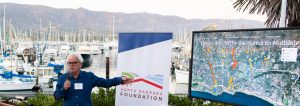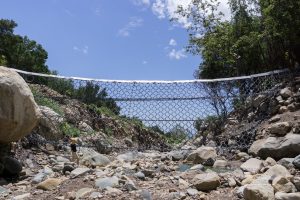BY DEAN ZATKOWSKY (Contributer)
“I often refer to philanthropy as ‘the art of the possible,” said Santa Barbara Foundation President & CEO Ron Gallo, “and the story of The Partnership for Resilient Communities is a case study in how innovative members of the community can come together to get important things done – and done quickly.”
Gallo’s comments were spurred by the County Board of Supervisors’ August 28 unanimous vote “providing performance security to the California Department of Fish and Wildlife for the Partnership for Resilient Communities’ Ring Net Project.”
That may sound a little obscure, but the action closes the circle of an unusual coordination of public and private activities and allows the completion of six steel ring nets in strategic backcountry locations that will mitigate debris flows until the return of burned flora above Montecito.

The Partnership for Resilient Communities (TPRC) was formed days after the January 9, 2018 debris flow that killed 23 people, caused hundreds of millions of dollars in damage, destroyed bridges, and closed the 101 freeway, cutting off essential transportation routes for people and emergency supplies.
Knowing that it would be years before the backcountry could recover from the Thomas Fire, TPRC studied how mountain-adjacent communities around the world dealt with similar situations, and came upon the proven idea of steel ring nets, placed across creeks to prevent boulders from gaining momentum when loosed during extreme weather events.
Having identified over 70 plausible locations where nets would be useful, TPRC focused its efforts on six critical locations, and began seeking permits and funding to get the nets in place before the next extreme weather event.

It takes a long time to become a registered charity, so TPRC turned to the Santa Barbara Foundation (SBF) for assistance. “With the Foundation as our fiscal sponsor, we were able to start raising money immediately,” said Alixe Mattingly of TPRC. “That we were ‘banking’ at SBF was critical because it gave our donors confidence. SBF also became an essential communication conduit, bringing our project to the attention of organizations like the Foundation Roundtable.”
The relationship proved even more valuable when TPRC faced a big surprise in the permitting process: To allow an expedited emergency permit, California Fish and Wildlife required an escrow account with over $1 million dollars on hand for contingencies related to net maintenance or organizational malfeasance.
TPRC hadn’t yet raised enough money to purchase and install all six nets, and now needed an extra million dollars in escrow, so Montecito Bank & Trust stepped up and took the risk of writing a loan to the fledgling organization. In an unprecedented move, the Santa Barbara Foundation basically “co-signed” the loan, taking on enormous risk, essentially using its own funds as collateral.
This innovative solution and advance enabled TPRC to order the supplies and pay contractors so work could begin immediately to install the first four nets in Buena Vista, San Ysidro and Cold Spring Canyons. TPRC could draw on it exclusively to pay the contractor, and to fund the cleanout escrow necessary to pull permits. TPRC would repay the Foundation as fundraising was completed.

“This short-term emergency response from the Foundation to speed up the net install, and not impair the urgency of our fundraising work, was a shining example of community stewardship,” said Pat McElroy, Executive Director of TPRC.
“To have the Montecito Bank & Trust and the Santa Barbara Foundation – two pillars of the community – provide this nimble assistance and willingness to take a risk has helped us stay nimble and focused on getting the nets up. With over 450 donors, and with contributions ranging from $10 to $100,000, it’s a model of public-private partnership.”
Which brings us back to the County Board of Supervisors. Their bold unanimous decision to fund the escrow account has actually saved TPRC enough money that the final two nets can be installed, and are scheduled for early October.
“We now have infrastructure in place to mitigate threats to life, property, and transportation,” said Jackie Carrera of SBF. “It’s a model of agility, really, because everyone involved went beyond their usual activities to make something happen quickly.”
McElroy adds, “Government usually takes longer than the private sector, all else equal, but when government partners with the private sector like this to get important things done, it’s a real triumph of community.”
The Partnership for Resilient Communities holds a fiscal sponsorship at the Santa Barbara Foundation. For more information please visit their website at partnershipsb.org.